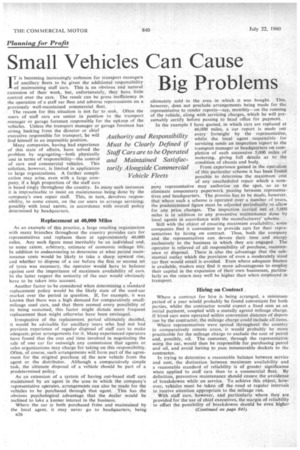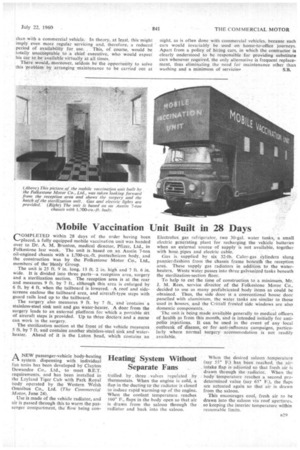Planning for Profit
Page 60

Page 63

If you've noticed an error in this article please click here to report it so we can fix it.
Small Vehicles Can Cause Big Problems
IT is becoming increasingly coenrnon for transport managers of ancillary fleets to be given the additional responsibility of maintaining staff cars. This is an obvious and natural extension of their work, but, unfortunately, they have little control over the cars. The result can be gross inefficiency in the operation of a staff car fleet and adverse repercussions on a previously well-maintained commercial fleet.
The reason for this situation is not far to seek. Often the users of staff cars are senior in position to the transport manager or garage foreman responsible for the upkeep of the vehicles. Unless the transport manager or garage foreman has strong backing from the director or chief executive responsible for transport, he will find himself in an impossible position.
Many companies, having had experience of this state of affairs, have solved the problem by segregating—both physically and in terms of responsibility—the control of cars and commercial vehicles. This solution, however, is limited in application to large organizations. A further complication may arise, even with a large company, if a high proportion of the staff cars is based singly throughout the country. In many such instances it is impracticable to insist on maintenance being done by the company's own repair staff. This, in turn, devolves responsibility, to some extent, on the car users to arrange servicing, possibly with local agents, in accordance with overall policy determined by headquarters.
Replacement at 40,000 Miles As an example of this practice, a large retailing organization with many branches throughout the country provides cars for representatives and replaces them at approximately 40,000 miles. Any such figure must inevitably be an individual and, to some extent, arbitrary, estimate of economic mileage life. In addition to endeavouring to determine at what period maintenance costs would be likely to take a sharp upward rise, and whether to dispose of a car before the first or second set of tyres was necessary, the operator would have to balance against cost the importance of maximum availability of cars. In the latter respect the seniority of the user would obviously have to be taken into account.
Another factor to be considered when determining a standard replacement policy would be the likely state of the used-car market over the period in question, if, for example, it was known that there was a high demand for comparatively smallmileage used ears, and that there seemed every possibility of its being sustained, this factor might dictate more frequent replacement than might otherwise have been envisaged.
Irrespective of the replacement period ultimately decided, it would be advisable for ancillary users who had not had previous experience of regular disposal of staff cars to make adequate, prior arrangements for it. Many experienced operators have found that the cost and time involved in negotiating the sale of one car far outweigh any commission that agents or sales organizations may charge for taking on this responsibility. Often, of course, such arrangements will form part of the agreement for the Original purchase of, the new vehicle from the agent or the distributor. Although a comparatively simple task, the ultimate disposal of a vehicle should be part of a predetermined policy.
As an extension of a system of having out-based staff cars maintained by an agent in the area in which the company's representative operates, arrangements can also be made for the vehicles to be purchased through that agent. This has the obvious psychological advantage that the dealer would be inclined to take a keener interest in the business.
Where the car is both purchased frOm and maintained by the local agent, it may never go to headquarters, being B26 ultimately sold in the area in which it was bought. This, however, does not preclude arrangements being made for the representative to render reports—say, monthly—on the running of the vehicle, along with servicing charges, which he will presumably certify before passing to head office for payment.
In the example I have quoted, in which cars are replaced at • 40,000 miles, a car report is made out every fortnight by the representative, whilst the local agent responsible for servicing sends an inspection report to the transport manager at headquarters on completion of each successive 5,000 miles of motoring, giving full details as to the condition of chassis and body.
From experience gained in the operation of this particular scheme it has been found possible to determine the maximum cost of any unscheduled repair which a company representative may authorize on the spot, so as to eliminate unnecessary paperwork passing between representatives and' headquarters. The proviso has to be made, however, that where such a scheme is operated over a number of years, the predetermined figure must be adjusted periodically to allow for any price changes. The inspection carried out at 54000 miles is in addition to any preventive maintenance done by local agents in accordance with the manufacturers' scheme.
Still with the object of ensuring maximum availability, son-re companies find it convenient to provide cars for their representatives by hiring on contract. Thus, both the company and the representatives can devote their time and energy exclusively to the business in which they are engaged. The operator is relieved of all responsibility of purchase, maintenance or disposal. There is also the advantage that the substantial outlay which the provision of even a moderately sized car fleet would entail is avoided. Even where adequate finance is available, traders may find it more advantageous to employ their capital in the expansion of their own businesses, particularly as the return may well be higher than when employed in transport.
Hiring on Contract.
Where a contract for hire is being arranged, a minimum period of a year would probably be found convenient for both parties, whilst the contractor would expect a fixed sum as an initial payment, coupled with a mutally agreed mileage charge. If hired cars were operated within convenient distance of depots run by the contractor, the mileage charge could include all items.
Where representatives were spread throughout the country in comparatively remote areas, it would probably be more practicable for the mileage charge to exclude the cost of petrol and, possibly, oil. The customer, through the representative using the car, would then be responsible for purchasing petrol and oil, and avoid having to pass innumerable dockets to the contractor.
In trying to determine a reasonable balarkee between service and cost, the distinction between maximum availability and a reasonable standard of reliability is of greater significance when applied to staff cars than to a commercial fleet. By definition, preventive maintenance should ensure the avoidance of breakdowns while on service. To achieve this object, however, vehicles must be taken off the road at regular intervals to receive attention appropriate to the mileage run.
With staff cars, however, and particularly where they are provided for the use of chief executives, the margin of reliability to offset the possibility of breakdowns should be even higher (Continued on page 841) than with a commercial vehicle. In theory, at least. this might imply even more regular servicing and, therefore, a reduced period of availability for use. This, of course, would be totally unacceptable to a chief executive, who would expect his car to be available virtually at all times.
There would, moreover, seldom be the opportunity to solve this problem by arranging maintenance to be carried out at night as is often done with commercial vehicles, because such cars would invariably be used on home-to-office journeys. Apart from a policy of hiring cars, in which the contractor is clearly understood to be responsible for providing substitute cars whenever required, the only alternative is frequent replacement, thus eliminating the need for maintenance other than washing and a minimum of servicinn S.B.




































































































